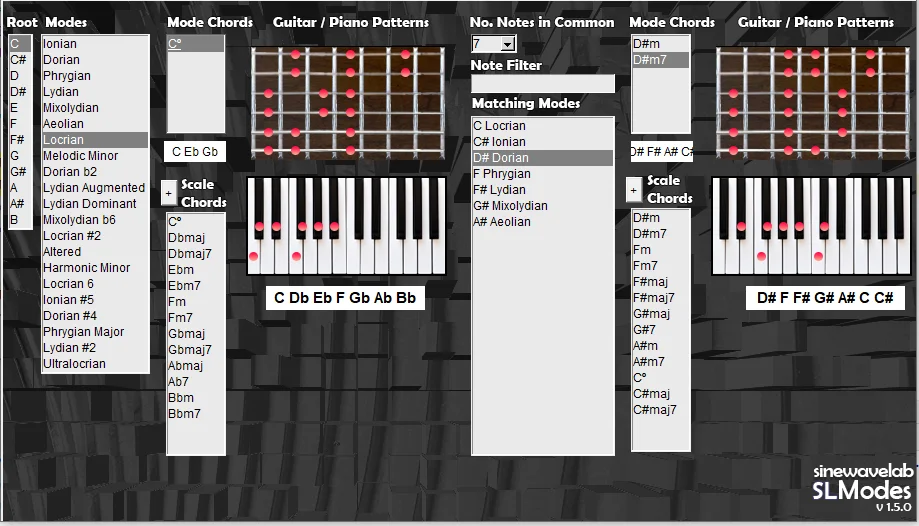The topic of guitar modes is often poorly explained and therefore misunderstood by beginners.
Faced with this initial difficulty, some even give up trying to understand the idea, and conclude that it is an advanced music theory topic that is inaccessible to them.
But it doesn’t have to be this way.
How It’s Usually Explained
What causes a lot of people confusion about the music modes (also known as Greek modes) is probably the same thing that caused it for me initially.
Usually, music modes are explained by:
- Starting with a scale that everyone knows well, such as the C Major Scale which notes are C D E F G A B.
- And explaining that each note corresponds to a musical mode, which in this case would be: C Ionian, D Dorian, E Phrygian, F Lydian, G Mixolydian, A Aeolian and B Locrian, with each mode having a certain feeling to it.
- Next, it is mentioned that to play one of these modes, for example A Aeolian, we simply need to change the order of the notes of the C Major Scale, so that they now begin in A:
So C, D, E, F, G, A,B becomes A, B, C, D, E, F, G.
Same notes, different order.
So What?
While this explanation is correct, what probably happens next is that you pick up your guitar.
You play one pattern starting in C…

You play the other starting in A…

…and simply don’t understand what all the fuss is about.
What is the big difference between playing the same scale starting with a different note?
It’s still the same notes, right?
Well, that is a valid question.
And you’re absolutely right.
There is no big difference.
You Need Chords
The reason you don’t hear or feel much difference is because the order of the notes is almost irrelevant.
To hear a music mode in all its glory, you need to hear the notes being played over certain chords.
That’s the big secret.
Which Chords?
To know which chords you should use, you need to be aware of this simple yet powerful bit of music theory:
“Every scale allows you to extract chords from it.”
The C Major Scale allows to extract many chords, but the main ones are:
C, D, E, F, G, A, B = C major (C E G)
C, D, E, F, G, A, B = D minor (D F A)
C, D, E, F, G, A, B = E minor (E G B)
C, D, E, F, G, A, B = F major (F A C)
C, D, E, F, G, A, B = G major (G B D)
C, D, E, F, G, A, B = A minor (A C E)
C, D, E, F, G, A, B = B diminished (B D F)
So now you know which chords you should use with the modes of the C Major Scale:
C Ionian is played over a C major chord.
D Dorian is played over a D minor chord.
E Phrygian is played over a E minor chord.
F Lydian is played over a F major chord.
G Mixolydian is played over a G major chord.
A Aeolian is played over a A minor chord.
B Locrian is played over a B diminished chord.
Also, for example:
You cannot play D Dorian over a D major chord (D F# A) because there’s no F# note in the C Major Scale, so you can’t extract that chord.
But you can play D Dorian over a D minor 7 chord (D F A C) because all those notes are present in the C Major Scale.
Chord Progressions
Okay, so that means that if I want to write a song in D Dorian, I can only use a D minor, or D minor 7 chord?
No.
I mean, you can if you want to. You can use a single D minor chord, or even just a simple D note playing as a drone for 5 minutes straight and play D Dorian over it. There are music genres like that.
But you can also use more complex chord progressions, for sure.
You just need to 1) start it with a D minor chord, 2) use any of the seven chords mentioned previously and 3) keep returning to that tonal center that is the D minor chord. Do this if you want to keep the Dorian feeling in your song.
An example of a D Dorian modal chord progression is: D minor – C major – G major
This proeminency of the D minor chord is why we shift C D E F G A B to D E F G A B C, even though the notes are the same. It’s to inform you that D minor is the tonal home to which you want to keep returning to.
It’s not so much to do with the licks or melodies you play. Don’t feel the need to think that “if I’m playing D Dorian, I must play licks that start and/or end in a D”.
In a Nutshell
So, to consolidate this lesson, these are the two things you need to do to, to start using the music modes in your music today:
- Choose a mode of your liking.
- Learn the notes of that mode across the fretboard.
- Know the chords that you can extract from that mode.
- Create modal chord progressions with some of those chords.
- Play the mode notes over those chord progressions.
Simple, really.
What, still confused?
Then, watch this video:
Exploring the Modes
Every music mode has its own characteristic sound. It is its own universe.
There are artists that took advantage of that, and their whole careers eventually became synonymous with certain modes:
- Steve Vai and Joe Satriani became synonymous with the Lydian mode.
- Carlos Santana with the Dorian mode.
- Iron Maiden with the Aeolian mode.
But up until now we’ve been focusing on the Major Scale and its 7 Modes.
However, there are many more music modes to explore. There are more Scales, such as Melodic Minor and Harmonic Minor and each of those have their own modes.

- These are the 7modes of the Melodic Minor Scale
- Melodic Minor
- Dorian b2
- Lydian Augmented
- Lydian Dominant
- Mixolydian b6
- Locrian #2
- Altered
- These are the 7modes of the Harmonic Minor Scale
- Harmonic Minor
- Locrian 6
- Ionian #5
- Dorian #4
- Phrygian Major
- Lydian #2
- Ultralocrian
Pretty exotic stuff!
Maybe you will explore these music modes and find one that you’ll fall in love with, and it ends up defining your music career! 😉
A music tool that exists to help with this exploration process was developed by me, and it’s called SLModes.

🟢 This software shows you a list of all the modes of these 3 Scales (and more), with their notes, guitar and piano shapes.
🟢 It gives you and instantaneous sound playback that lets you listen to how a mode sounds and feels like played over a chord.
🟢 It gives you quick access to the chords you can extract from a Scale, and since it gives you a sound playback, it allows you to easily create modal chord progressions that sound good.
…and this is only half of what the software does.
The other half is ever cooler because it deals with music theory concepts such as Modal Modulation/Interchange, Pitch Axis, and Negative Harmony.
To learn more, check the product page.



